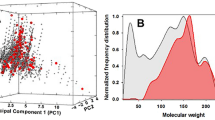Abstract
THERE are two types of physicochemical theory of general anaesthesia. The Meyer–Overton and related theories correlate the potency of an anaesthetic with its solubility in lipids1–3, implying that the site of action of the anaesthetic gas is in the lipid part of the nerve membrane. The hydrate theories4,5 correlate the potency of an anaesthetic with its hydrate dissociation pressure, implying that the site of action of the anaesthetic is in the aqueous phase in or near the nerve membrane. For most anaesthetics the correlations are of similar quality. It has been proposed6–8 that fluorinated gases, because of their anomalous physical properties, could provide a means of discrimination between these two types of theories. Using the righting reflex in mice as a test for anaesthesia, CF4 was shown to be anaesthetic at 19 atmospheres and SF6 at 6.9 atmospheres7,8. These values correlate fairly well with those values predicted from their lipid solubility1–3. The correlation with the hydrate theories of anaesthesia4,5 was poor—published values at the dissociation pressures are roughly 1 atmosphere for CF4 hydrate9 and 1.0 atmosphere for SF6 hydrate10 at 0° C. The correlation was particularly bad for CF4 where the anaesthetic pressure was far greater than that predicted from the hydrate dissociation pressure. This lack of correlation makes the hydrate theories doubtful.
This is a preview of subscription content, access via your institution
Access options
Subscribe to this journal
Receive 51 print issues and online access
$199.00 per year
only $3.90 per issue
Buy this article
- Purchase on Springer Link
- Instant access to full article PDF
Prices may be subject to local taxes which are calculated during checkout
Similar content being viewed by others
References
Meyer, K. H., and Gottlieb-Billroth, H., Z. Physiol. Chem., 112, 55 (1920).
Meyer, K. H., Trans. Faraday Soc., 33, 1062 (1937).
Mullins, L. J., Chem. Rev., 54, 289 (1954).
Pauling, L., Science, 134, 15 (1961).
Miller, S. L., Proc. US Nat. Acad. Sci., 47, 1515 (1961).
Dawe, R. A., Miller, K. W., and Smith, E. B., Nature, 204, 789 (1964).
Miller, K. W., Patton, W., and Smith, E. B., Nature, 206, 574 (1965).
Miller, K. W., Patton, W., and Smith, E. B., Brit. J. Anaesth., 39, 910 (1967).
Villard, P., CR Acad. Sci., 111, 302 (1890). Quoted by Van der Waals, J. H., and Platteeuw, J. C., Adv. Chem. Phys., 2, 1 (1959).
Shortland, L. D., and Robinson, D. B., Canad. J. Chem. Eng., 42, 38 (1964).
Eger, E. I. (II), Saidman, L. J., and Brandstater, B., Anesthesiology, 26, 756 (1965).
Chabrié, C., CR Acad. Sci., 110, 279 (1890).
Moissan, H., CR Acad. Sci., 110, 951 (1890).
Lebeau, P., and Damiens, A., CR Acad. Sci., 182, 1340 (1926).
Eger, E. I. (II), Lundgren, C., Miller, S. L., and Stevens, W. C., Anesthesiology (in the press).
Harrison, R. H., and Douslin, D. R., J. Chem. Eng. Data, 11, 383 (1966).
Hafemann, D. R., and Miller, S. L., J. Phys. Chem. (in the press).
Author information
Authors and Affiliations
Rights and permissions
About this article
Cite this article
MILLER, S., EGER, E. & LUNDGREN, C. Anaesthetic Potency of CF4 and SF6 in Dogs. Nature 221, 468–469 (1969). https://doi.org/10.1038/221468a0
Received:
Revised:
Issue Date:
DOI: https://doi.org/10.1038/221468a0
This article is cited by
-
Thermodynamic studies of clathrate hydrates
Journal of Thermal Analysis (1989)
Comments
By submitting a comment you agree to abide by our Terms and Community Guidelines. If you find something abusive or that does not comply with our terms or guidelines please flag it as inappropriate.



